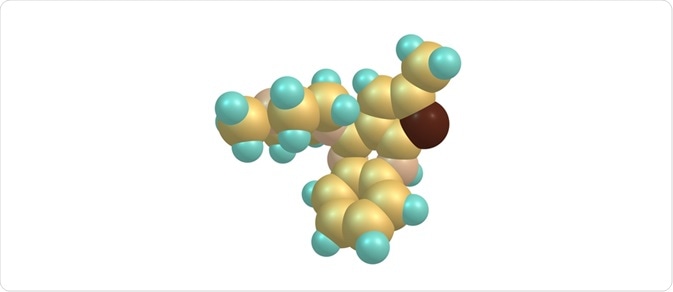Olanzapine (2-methyl-4-(4-methyl-1-piperazinyl)-10H-thieno[2,3-b][1,5]benzodiazepine) is a second generation (also called “atypical”) antipsychotic agent related to clozapine. It has a complex pharmacology, interacting with the D1 and D2 dopamine receptors, multiple serotonin receptors, histamine receptors, as well as muscarinic cholinergic receptors.
Olanzapine blocks serotonin receptors more strongly than dopamine receptors, which is a proposed mechanism for effects on negative symptoms in schizophrenia. Anticholinergic effect due to muscarinic blocking and lower affinity for dopamine receptors may account for the decreased incidence of extrapyramidal symptoms seen with this drug. The effect on prolactin levels is minimal.
 Image Credit: Igor Petrushenko / Shutterstock.com
Image Credit: Igor Petrushenko / Shutterstock.com
Pharmacokinetics of the drug
The pharmacokinetics of olanzapine is linear and dose-proportional within the approved dosage range. The mean half-life of the in healthy individuals is 33 hours, ranging from 21 to 54 hours. The mean apparent plasma clearance is 26 liters in an hour. Smokers and men have a higher clearance of olanzapine when compared to nonsmokers and women, and age can also play a role (elimination of olanzapine can be slower in the elderly).
The drug is well absorbed after oral administration (not influenced by food) with peak plasma levels occurring after 5-8 hours. Plasma levels have a correlation with therapeutic effect, although the onset of antipsychotic effects can be seen after 1-2 weeks of treatment.
Olanzapine is highly protein bound, predominantly to albumin (90%) and α1-acid-glycoprotein (77%). Pharmacodynamic interactions can occur between olanzapine and alcohol, but also olanzapine and imipramine, which imply that patients should avoid operating hazardous equipment or driving a vehicle while experiencing the short-term effects of these combinations.
 Image Credit: Cagkan Sayin / Shutterstock.com
Image Credit: Cagkan Sayin / Shutterstock.com
Metabolism of olanzapine
Olanzapine is a lipophilic compound, which means that it needs to be metabolized to water-soluble molecules prior to its excretion via urine or bile. The metabolism of olanzapine is generally divided into phase I and phase II reactions, both involving specific enzymes.
In reactions during phase I, the primary molecular structure is modified by reactions such as reduction, oxidation or hydrolysis. Although certain phase I metabolites are sufficiently polar for direct excretion in urine or bile, phase I reactions may also facilitate further metabolism of the molecules (phase II). The most important enzyme systems in this phase are the cytochrome P450 (CYP) superfamily and flavin-containing monooxygenase (FMO).
Primary molecules are conjugated to co-substrates like glucuronic acid, amino acids, glutathione or sulfate in phase II metabolism. Direct glucuronidation of a functional group on the parent molecule can be observed in the case of olanzapine, resulting in inactive molecules. The superfamily of uridine diphosphate glycosyltransferase (UGT) enzymes is important in this step.
References
Further Reading
Last Updated: Dec 19, 2022